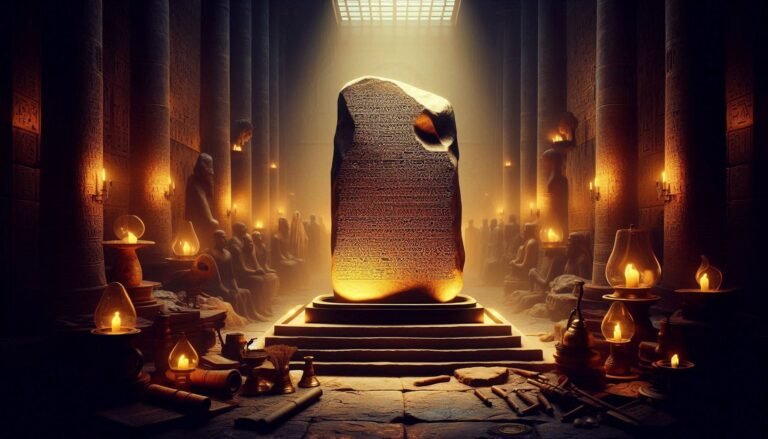The Nile River has been the lifeblood of Egyptian civilization for thousands of years, giving rise to magnificent cities that once flourished as centers of trade, religion, and power. While some, like Thebes and Memphis, have maintained their place in historical records, others have been lost to time, buried beneath the desert sands or submerged beneath the waters. Thanks to modern archaeology, many of these lost cities are being rediscovered, revealing the incredible complexity and grandeur of ancient Egyptian civilization. Here, we explore some of the most fascinating forgotten cities of the Nile.
1. Thonis-Heracleion: Egypt’s Sunken City
For centuries, the existence of Thonis-Heracleion was known only through ancient texts and legends. This fabled port city, once a vital trade hub of Egypt, mysteriously disappeared beneath the Mediterranean Sea over 1,200 years ago. In 2000, archaeologist Franck Goddio and his team made a groundbreaking discovery, locating the submerged ruins of Thonis-Heracleion near the present-day city of Alexandria.
The city, believed to have been founded around the 8th century BCE, served as the gateway to Egypt before the rise of Alexandria. It was a bustling center of commerce and religion, featuring colossal statues of gods, grand temples, and a sophisticated harbor system. The remains of temples dedicated to Amun-Gereb and Hercules suggest the city’s spiritual significance.
Its submersion is thought to have been caused by a combination of rising sea levels, earthquakes, and soil liquefaction, which led to the city’s gradual sinking into the sea. Today, Thonis-Heracleion continues to yield astonishing artifacts that shed light on its former glory.
2. Pi-Ramesses: The Lost Capital of Ramses the Great
During the reign of Ramses II (1279–1213 BCE), Pi-Ramesses was one of the most magnificent cities of the ancient world. Located in the eastern Nile Delta, this city served as the capital of Egypt and was renowned for its grand palaces, sprawling temples, and advanced infrastructure. It was a symbol of Ramses II’s military power and ambition.
However, in later centuries, the city mysteriously disappeared. Archaeologists long searched for Pi-Ramesses, believing it to be located near Tanis, but modern excavations have revealed that the city was actually built at Qantir. The Nile’s shifting course likely forced the population to abandon Pi-Ramesses, leading to its eventual decline and disappearance.
Today, excavations at the site have uncovered remnants of statues, chariot parts, and evidence of an advanced water management system, indicating the city’s former greatness.
3. Avaris: The City of the Hyksos
Before Pi-Ramesses, the city of Avaris (modern-day Tell el-Dab’a) was a major capital in the Nile Delta, serving as the seat of power for the Hyksos, a foreign dynasty that ruled parts of Egypt during the Second Intermediate Period (c. 1650–1550 BCE).
Avaris was a thriving trade center, heavily influenced by Canaanite and Near Eastern cultures. Archaeological excavations have uncovered multi-story houses, palaces, horse remains, and elaborate burial sites, which suggest that the Hyksos introduced horses and chariots to Egypt.
The city met its downfall when Ahmose I, the founder of the New Kingdom, launched a military campaign to expel the Hyksos from Egypt. Avaris was abandoned and eventually forgotten, but its rediscovery has provided crucial insights into the Hyksos’ influence on Egyptian warfare and society.
4. Amarna: The City of the Sun God
Amarna was the short-lived capital built by Pharaoh Akhenaten in the 14th century BCE as the center of his revolutionary religious movement. Abandoning the traditional Egyptian pantheon, Akhenaten dedicated his city to the worship of Aten, the sun god, making it a unique and radical departure from Egyptian religious traditions.
The city was constructed in a rush and featured grand palaces, wide streets, and the famous Great Temple of Aten. However, after Akhenaten’s death, his successor Tutankhamun abandoned Amarna, restoring the traditional gods and moving the capital back to Thebes. Amarna was systematically dismantled, and its history was nearly erased by later pharaohs who saw Akhenaten’s rule as heretical.
Despite its short lifespan, Amarna provides an unparalleled look into one of the most controversial and transformative periods in Egyptian history. The discovery of personal letters and detailed murals has helped historians reconstruct daily life in this extraordinary city.
5. Tanis: The Treasure City
Often called “Egypt’s second Thebes,” Tanis was a powerful city in the Third Intermediate Period (c. 1070–664 BCE). It served as the capital of the 21st and 22nd Dynasties and was home to magnificent temples dedicated to Amun, Mut, and Khonsu.
Tanis gained worldwide fame when archaeologists uncovered a royal necropolis in the 1930s, filled with golden treasures comparable to those found in Tutankhamun’s tomb. Unlike other ancient cities lost to the sands or submerged underwater, Tanis remained occupied for centuries, though it was eventually eclipsed by other centers of power.
Today, Tanis continues to intrigue archaeologists, as much of its grandeur still lies buried beneath layers of rubble and sand.
The Future of Egypt’s Lost Cities
With advancements in satellite imaging, ground-penetrating radar, and underwater archaeology, the search for lost cities in Egypt is far from over. Recent discoveries hint at the possibility of even more hidden settlements buried beneath the desert sands and submerged along the ancient coastline of the Mediterranean.
As new excavations continue, we may one day uncover even more forgotten cities, shedding light on Egypt’s rich and complex history. Each lost city tells a unique story of triumph, innovation, and, ultimately, decline—reminders of the ever-changing nature of civilization.
The sands of Egypt hold many secrets, waiting to be unearthed. Who knows what future archaeologists may discover beneath the shifting dunes and ancient riverbeds of the Nile?






